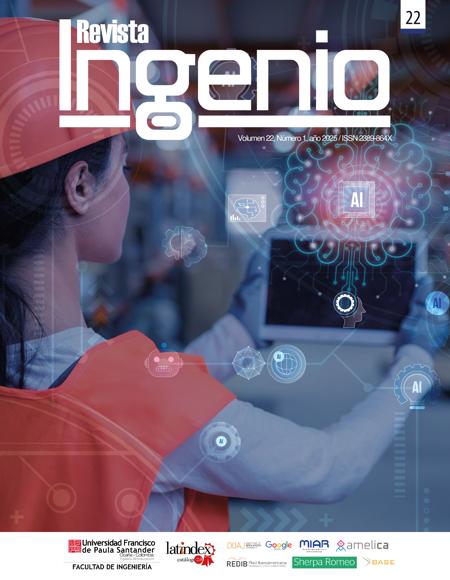Predictive analysis of hypertension risk in Mexican adults based on nutritional and caloric indicators
Análisis predictivo del riesgo de hipertensión en adultos mexicanos basado en indicadores nutricionales y calóricos
Main Article Content
This article develops a predictive analysis of hypertension risk in Mexican adults based on nutritional and caloric indicators. Hypertension, a condition with serious health implications, requires the identification of predictive risk factors for its prevention and effective management. Several machine learning models were evaluated, with the Random Forest model standing out for its high accuracy and robustness, while XGBoost excelled in efficiency with large datasets. In contrast, the Naive Bayes model showed the lowest performance. Additionally, the study emphasizes the importance of macronutrients and total caloric intake in predicting hypertension, with proteins, carbohydrates, and lipids being relevant risk factors, especially in young adults in Mexico. This finding highlights the need to integrate multiple nutritional factors in risk assessment.
Downloads
Article Details
O. G. Montero Cadena, G. J. Guzmán Kure, R. C. Acosta Bravo, and M. B. Peñafiel Peñafiel, “Principales factores de riesgo de la hipertensión arterial,” RECIMUNDO, vol. 7, no. 2, pp. 89–97, Jun. 2023, doi: 10.26820/recimundo/7.(2).jun.2023.89-97.
J. M. Baglietto-Hernández, A. Mateos-Bear, J. P. Nava-Sánchez, P. Rodríguez-García, and F. Rodríguez-Weber, “Nivel de conocimiento en hipertensión arterial en pacientes con esta enfermedad de la Ciudad de México,” Medicina Interna de México, vol. 36, no. 1, pp. 1–14, 2020, doi: https://doi.org/10.24245/mim.v36i1.2844.
J. Plaza-Torres, A. Martínez-Sánchez, and R. Navarro-Suay, “Hábitos alimenticios, estilos de vida y riesgos para la salud. Estudio en una población militar,” Sanidad Militar, 2022, doi: https://dx.doi.org/10.4321/s1887-85712022000200004.
N. Díaz Wever, H. Herrera Mogollón, Z. Fajardo, and A. Galbán Chinchilla, “Consumo de macronutrientes y micronutrientes en adolescentes,” TAYACAJA, vol. 4, no. 1, pp. 180–192, Jun. 2021, doi: 10.46908/tayacaja.v4i1.163.
I. Campos-Nonato et al., “Prevalencia, tratamiento y control de la hipertensión arterial en adultos mexicanos: resultados de la Ensanut 2022,” Salud Publica Mex, vol. 65, pp. 169– 180, 2023.
L. Alcocer et al., “A reflection on the results of the ENSANUT 2022 on high blood pressure in Mexican adults,” Cardiovascular and Metabolic Science, vol. 34, no. 3, pp. 85–93, 2023.
S. Hasdeu, L. LAMFRE, P. CARO, and Federico. HORNE, “Revisión narrativa: modelos predictivos sobre la evolución de la pandemia por COVID-19,” Rev Argent Salud Publica, vol. 12, p. 3, [Online]. Available: http://www.scielo.org.ar/scielo.php?script=sci_abstract&pid=S1853-810X2020000300003&lng=es&nrm=iso&tlng=es
D. Delen, G. Walker, and A. Kadam, “Predicting breast cancer survivability: a comparison of three data mining methods,” Artif Intell Med, vol. 34, no. 2, pp. 113–127, Jun. 2005, doi: 10.1016/j.artmed.2004.07.002.
R. BELLAZZI and B. ZUPAN, “Predictive data mining in clinical medicine: Current issues and guidelines,” Int J Med Inform, vol. 77, no. 2, pp. 81–97, Feb. 2008, doi: 10.1016/j.ijmedinf.2006.11.006.
M. Araujo-Castro et al., “Predictive model of hypertension resolution after adrenalectomy in primary aldosteronism: the SPAIN-ALDO score,” J Hypertens, vol. 40, no. 12, pp. 2486–2493, Dec. 2022, doi: 10.1097/HJH.0000000000003284.
L. M. Ruilope et al., “PREDICTIVE PERFORMANCE AND CLINICAL UTILITY OF A NEW PREDICTIVE MODEL OF CARDIOVASCULAR RISK FOR YOUNG AND MIDDLE-AGED WORKING POPULATION,” J Hypertens, vol. 36, no. Supplement 1, p. e221, Jun. 2018, doi: 10.1097/01.hjh.0000539624.20457.e0.
C. Fernández-Labandera Ramos et al., “Estrategia clínica para reducir la enfermedad cardiovascular: integración de Iberscore y Life’s simple 7 de la American Heart Association,” Rev Esp Cardiol, vol. 71, no. Suplemento 1, p. 1306, 2018, [Online]. Available: http://www.revespcardiol.org/es-congresos-sec-2018-el-congreso-76-sesion-biomarcadores-escalas-riesgo-4438-estrategia-clinica-reducir-enfermedad-cardiovascular-52373
Q. Luo, K. Bao, W. Gao, Y. Xiang, M. Li, and Y. Zhang, “Joint effects of depressive status and body mass index on the risk of incident hypertension in aging population: evidence from a nationwide population-based cohort study,” BMC Psychiatry, vol. 23, no. 1, p. 608, Aug. 2023, doi: 10.1186/s12888-023-05105-z.
A. D. Argoty-Pantoja, R. Velázquez-Cruz, J. Meneses-León, J. Salmerón, and B. Rivera-Paredez, “Triglyceride-glucose index is associated with hypertension incidence up to 13 years of follow-up in mexican adults,” Lipids Health Dis, vol. 22, no. 1, p. 162, Sep. 2023, doi: 10.1186/s12944-023-01925-w.
S. Kendale, P. Kulkarni, A. D. Rosenberg, and J. Wang, “Supervised Machine-learning Predictive Analytics for Prediction of Postinduction Hypotension,” Anesthesiology, vol. 129, no. 4, pp. 675–688, Oct. 2018, doi: 10.1097/ALN.0000000000002374.
C.-D. Tseng, A. M.-F. Yen, S. Y.-H. Chiu, L.-S. Chen, H.-H. Chen, and S.-H. Chang, “A Predictive Model for Risk of Prehypertension and Hypertension and Expected Benefit After Population-Based Life-Style Modification (KCIS No. 24),” Am J Hypertens, vol. 25, no. 2, pp. 171–179, Feb. 2012, doi: 10.1038/ajh.2011.122.
Martínez de Castro. Georgina Toussaint, A. B. Pérez Lizaur, H. R. García Hernández, and A. F. García Martínez, “Contenido nutrimental de los alimentos,” in Nutrición y gastroenterología pediátrica, 2013.
I.B.M., “Conceptos básicos de ayuda de CRISP-DM,” in Obtenido de Guía de CRIPS-DM de IBM SPSS Modeler, 2021. [Online]. Available: https://www.ibm.com/docs/es/spss-modeler/saas?topic=dm-crisp-help-overview
D. J. Gottlieb, S. Redline, F. J. Nieto, C. M. Baldwin, A. B. Newman, H. E. Resnick, ... and N. M. Punjabi, "Association of usual sleep duration with hypertension: the Sleep Heart Health Study," Sleep, vol. 33, no. 8, pp. 1011-1018, 2010.
T. M. Spruill, "Chronic psychosocial stress and hypertension," Current Hypertension Reports, vol. 12, pp. 10-16, 2010.
D. Berrar, “Cross-Validation,” in Encyclopedia of Bioinformatics and Computational Biology, Elsevier, 2019, pp. 542–545. doi: 10.1016/B978-0-12-809633-8.20349-X.
K. Hajian-Tilaki, "Receiver Operating Characteristic (ROC) curve analysis for medical diagnostic test evaluation," Caspian Journal of Internal Medicine, vol. 4, no. 2, pp. 627-635, 2013.
D. V. Carvalho, E. M. Pereira, and J. S. Cardoso, “Machine Learning Interpretability: A Survey on Methods and Metrics,” Electronics (Basel), vol. 8, no. 8, p. 832, Jul. 2019, doi: 10.3390/electronics8080832.
M. Kuhn and K. Johnson, Applied predictive modeling. New York: Springer, 2013.
J. A. Martínez Pérez and P. S. Pérez Martin, “La curva ROC,” Medicina de Familia. SEMERGEN, vol. 49, no. 1, p. 101821, Jan. 2023, doi: 10.1016/j.semerg.2022.101821.
V. Morales-Oñate, L. Moreta, and B. Morales-Oñate, “SMOTEMD: UN ALGORITMO DE BALANCEO DE DATOS MIXTOS PARA BIG DATA EN R,” Perfiles, vol. 1, no. 24, 2020.




 Perfil Google Scholar
Perfil Google Scholar



